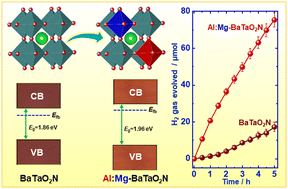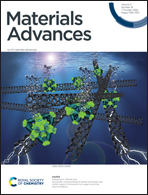Exploring the effect of partial B-site Al3+–Mg2+ dual substitution on optoelectronic, surface, and photocatalytic properties of BaTaO2N†
Abstract
BaTaO2N is appraised to be one of the few promising 600 nm-class photocatalysts for solar water splitting. However, the presence of structural defects and low charge separation limits its photocatalytic activity. Compared with mono substitution, dual substitution can be more effective in engineering the structural defects and improving the photocatalytic activity if foreign ions are suitably selected. In this work, we involve a dual-substitution approach to partially substitute Al3+ and/or Mg2+ for Ta5+ in BaTaO2N. By maintaining the maximum concentration of Al3+–Mg2+ dual substitution at 5%, the effect of the Al3+–Mg2+ cosubstituent ratio on the optoelectronic, surface, and photocatalytic properties of BaTaO2N is investigated. The Al3+–Mg2+ dual substitution leads to the shift of optical absorption edge toward shorter wavelengths, increasing the optical bandgap energy of BaTaO2N. This effect is more pronounced in the samples with a higher concentration of Mg2+ due to the replacement of N3− by a large number of O2− to compensate charge balance. The initial reaction rates for the evolution of O2 and H2 reveal the improvement in the photocatalytic activity of BaTaO2N due to the partial Al3+–Mg2+ dual substitution. Higher O2 evolution is observed in the samples with a higher concentration of Mg2+, while the H2 evolution rate significantly relies on the increased concentration of Al3+. According to the density functional theory (DFT) calculations, the effective masses of electrons become slightly lower than that of pristine BaTaO2N after partial Al3+–Mg2+ (co)substitution, while a contrary tendency is observed for the effective masses of holes. The calculated positions of the valence band maximum and conduction band minimum are aligned with respect to the normal hydrogen electrode (NHE), and partial Al3+–Mg2+ (co)substituted BaTaO2N photocatalysts can be promising candidates for visible-light-induced water splitting.

- This article is part of the themed collection: Celebrating materials science in Japan and South Korea


 Please wait while we load your content...
Please wait while we load your content...